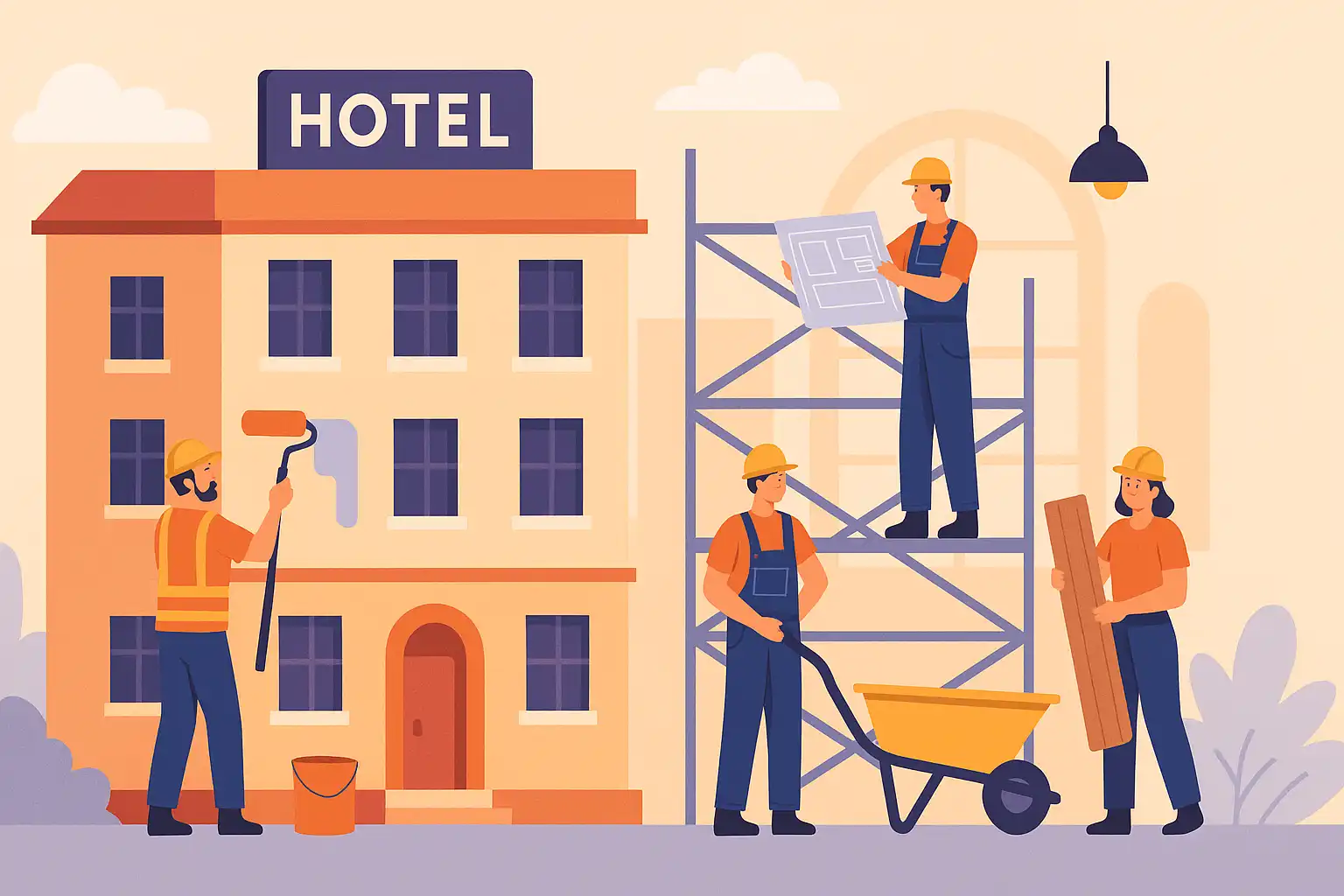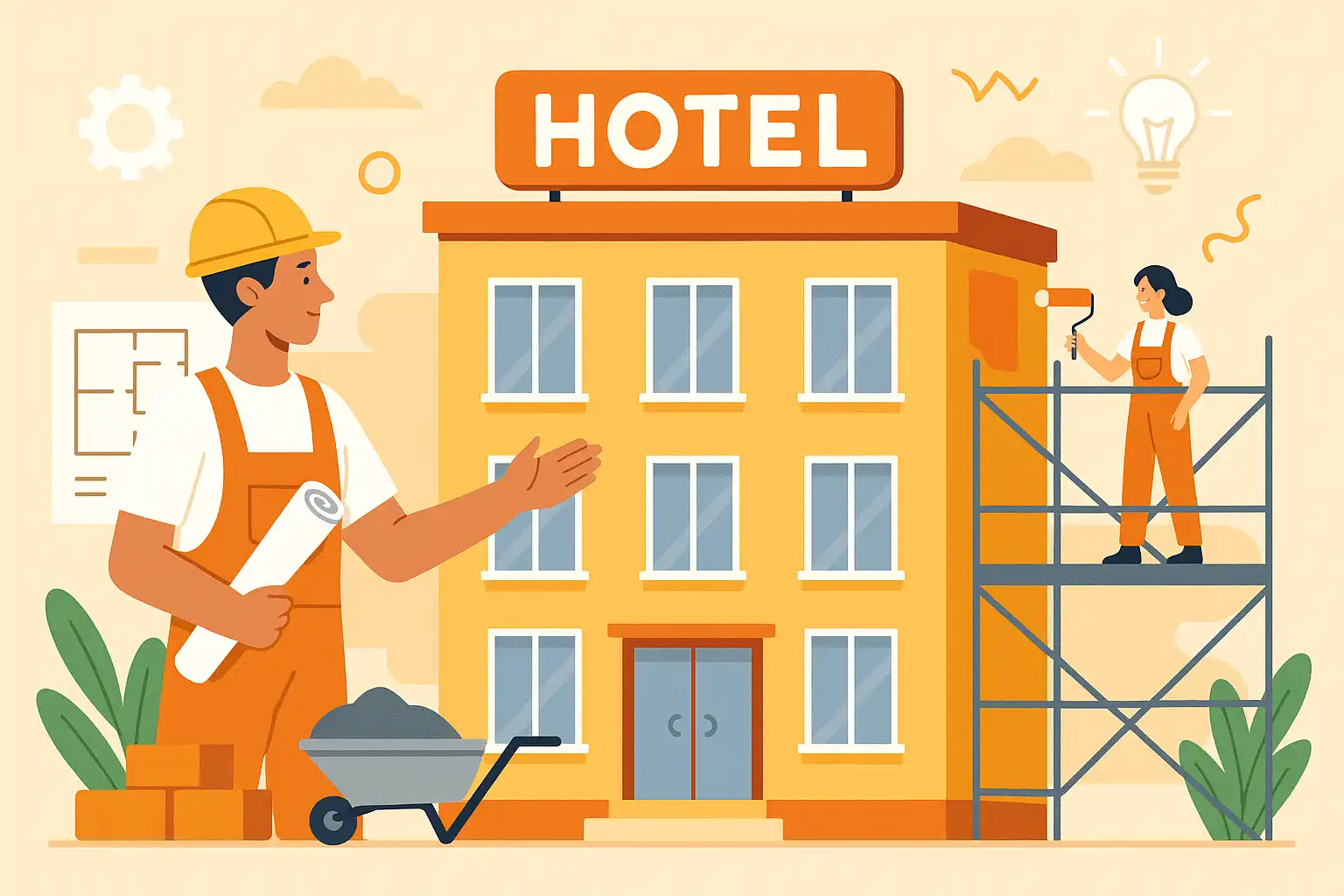Hotel Renovation: Complete Guide to Transforming Your Property
Oct 8, 2025
 Mika Takahashi
Mika TakahashiPopular Categories
Hotel Technology & InnovationHotel Operations OptimizationDigital MarketingIndustry TrendsRevenue ManagementHospitality Industry
Popular Categories
Trending Post

Hotel Walk Letter Template: Professional Guest Communication

Online Travel Agents: What They Are and How They Work

Hotel Security Systems: Modern Protection Solutions

Hotel Advertising: Complete Guide to Boost Bookings and Revenue

25 Hotel Marketing Strategy Ideas for 2025: Complete Guide

AI Reservation Agent: Revolutionizing Hotel Booking and Guest Experience

PMS Communication: Streamlining Property Management Through Effective Guest Messaging
Table of contents
The hospitality industry is more competitive than ever. With guest expectations constantly rising and new hotels popping up all the time, staying ahead means investing wisely in your property’s future. Hotel renovation is one of the best ways to boost guest satisfaction, increase your revenue, and protect the long-term value of your asset.
Whether you run a cozy boutique hotel in San Diego or manage a portfolio of luxury properties, knowing the ins and outs of the renovation process can be the difference between thriving and just getting by. This all-in-one guide will take you through everything—from spotting when your hotel needs a refresh to making the most of your investment.
What is Hotel Renovation and Why It Matters
Simply put, hotel renovation is the planned effort to update, refresh, or redesign parts of your hotel to keep it functional, attractive, and competitive. This can be anything from minor updates like repainting walls and replacing outdated furniture to full-scale renovation projects that revamp guest rooms, common areas, and even the hotel’s exterior.
It’s important to know the difference between renovation and a hotel remodel. Renovation usually means improving or replacing what’s already there—like new flooring, better lighting fixtures, or a lobby makeover. Remodeling, on the other hand, involves changing the layout or structure itself, such as merging rooms or redesigning meeting spaces.

In 2025, hotel renovations have become essential for several key reasons:
Guest Expectations Keep Rising Travelers today want modern amenities, the latest technology, and spaces that look and feel fresh. Hotels that don’t keep up risk lower guest satisfaction scores and negative reviews, which can hurt bookings and revenue.
Protecting and Growing Revenue Well-timed hotel renovations often lead to average daily rate increases of 7-20% and occupancy gains of 5-10% in competitive markets. Done right, the renovation process opens doors to premium pricing that improves your bottom line.
Maintaining Property Value Regular updates keep your hotel looking sharp and functioning well, which helps maintain or even increase its market value. A well-kept property gets better financing terms and higher appraisals.
Meeting Brand Standards For franchised hotels, Property Improvement Plans (PIPs) require hotel renovations every 5-15 years to stay in line with brand expectations. Staying compliant means keeping your brand affiliation and access to bookings.
Key Indicators Your Hotel Needs Renovation
Knowing when to renovate can save you from costly problems down the line and keep your guests happy. Here are some primary focus areas that signal it’s time for a renovation:
Visible Wear and Tear:
- Carpets with stains, odors, or worn patches in rooms or common areas
- Walls with peeling paint, fading, or water damage
- Outdated or damaged furniture that looks tired or out of style
- Broken or flickering light fixtures
- Bathroom fixtures showing rust or other issues
- The hotel’s exterior giving a bad first impression due to faded signage, cracked parking lots, or unkempt landscaping
Guest Feedback Trends:
- Declining satisfaction scores, especially about room quality and appearance
- Negative reviews mentioning old décor, worn furniture, or maintenance problems
- Fewer guests extending their stays or returning
- Comments about rooms feeling outdated or missing modern amenities
Operational and Safety Concerns:
- Building code violations or needed safety upgrades
- HVAC systems that break down often or don’t keep rooms comfortable
- Plumbing problems affecting water pressure or requiring frequent fixes
- Electrical systems that can’t support modern technology or pose safety risks
Technology and Amenity Gaps:
- WiFi that can’t handle streaming or video calls
- Not enough USB outlets or charging stations in rooms
- Outdated entertainment systems
- No mobile check-in or digital kiosks
- Energy-inefficient or unreliable mini fridges
Competitive Disadvantages:
- Other hotels in your area renovating and gaining market share
- Difficulty charging competitive room rates because of perceived value gaps
- Lost group bookings due to outdated meeting rooms or common spaces
- Brand representatives signaling upcoming PIP requirements
Financial Red Flags:
- Dropping average daily rates compared to competitors
- Fewer repeat guests
- Rising maintenance costs as things age
- Increasing energy bills from inefficient lighting, HVAC, or appliances
When you see several of these signs together, it’s a clear signal to start planning a renovation. Minor refreshes are usually needed every 3-5 years, with major renovations every 7-10 years to keep up with guest expectations and the competition.
Hotel Renovation Ideas by Area
Smart hotel renovation ideas focuses on high-impact upgrades while keeping an eye on costs. Organizing your renovation project by area helps you create a comprehensive renovation plan that satisfies guests and improves operations.
Exterior and Curb Appeal Upgrades
Your hotel’s exterior is the first thing guests see, so making it look inviting is a must. A great first impression can set the tone for the entire stay.
Facade and Building Improvements: Power washing can freshen up your building for just a couple thousand dollars. A new coat of paint might cost $8,000 to $25,000 depending on size but instantly lifts your hotel’s appearance. Adding new awnings, modern entrance features, or updated signage can really make your property stand out.
Landscaping and Outdoor Spaces: Investing in professional landscaping and irrigation upgrades (usually $5,000 to $20,000) creates year-round curb appeal. Adding patios, fire pits, or garden areas gives guests extra places to relax and can justify higher rates.
Lighting and Safety: Switching to LED lighting cuts energy costs by 50-70% and improves safety. Motion sensors and well-lit walkways make your property welcoming after dark.
Parking and Accessibility: Resurfacing and restriping parking lots ($3,000-$15,000) improve first impressions. Don’t forget ADA compliance updates to keep things legal and accessible.
Budget for exterior renovations generally ranges from $15,000 to $75,000 for a full refresh, with a solid return on investment through higher bookings and room rates.
Lobby and Common Area Transformations
The lobby is your hotel’s heart and a key spot to invest in. Today’s lobbies are designed to be flexible, tech-friendly, and welcoming.

Layout and Furniture: Open floor plans with modular seating cater to business travelers and leisure guests alike. Furniture that can be rearranged keeps the space adaptable from morning coffee to evening social hours.
Tech Features: Digital kiosks speed up check-in and check-out, while charging stations meet the needs of today’s device-dependent travelers. Fast WiFi supports the lobby as a casual coworking spot.
Lighting and Ambiance: Combining natural light with layered accent and ambient lighting creates a warm, inviting atmosphere. Featuring local artists’ work adds unique character and community connection.
Multi-Use Spaces: Modern lobbies often have quiet zones for work, social areas, and even retail spots. This mix maximizes space and guest satisfaction.
Lobby renovations usually cost between $25,000 and $150,000 depending on size and scope, but they pay off with happier guests and a stronger market position.
Guest Room Renovations
Guest rooms are your core product, so investing here yields the biggest impact on guest satisfaction and revenue.
Bathroom Upgrades: Bathrooms offer the best bang for your buck in guest satisfaction. New lighting, modern vanities, and stylish tile work create a spa-like feel. Low-flow fixtures save water and appeal to eco-conscious guests. Expect to spend $8,000-$15,000 per room for a full bathroom refresh.
Bedroom Comfort: New mattresses and bedding improve sleep quality and reviews. Smart TVs with streaming, well-lit workspaces, and plenty of outlets make rooms more functional. USB charging spots are a must.
Flooring: Luxury vinyl plank flooring is durable and looks great, while new carpet reduces noise. Flooring upgrades cost $3,000-$8,000 per room but last for years.
Storage: Thoughtful closet space, luggage racks, and organization solutions help guests feel at home and make rooms seem bigger.
Guest room renovations typically range from $12,000 to $75,000 per room depending on hotel category and scope. Luxury properties invest more, while select-service hotels can still make big improvements on a smaller budget.
Technology and Digital Infrastructure
Tech upgrades are essential to meet guest expectations and improve hotel operations.
WiFi and Connectivity: High-speed internet with full coverage supports streaming, video calls, and multiple devices. Professional assessments ensure no dead zones. Budgets range from $10,000 to $50,000 depending on size.
Smart Room Features: Digital thermostats save energy with occupancy sensors. Smart locks improve security and cut key card hassles. Apps let guests control lighting, temperature, and entertainment from their phones.
Entertainment and Communication: Smart TVs with streaming apps, in-room tablets with hotel info and service requests, and voice assistants all add convenience.
Property Management Systems: Modern PMS with mobile check-in smooths front desk operations and appeals to guests who prefer contactless service.
Tech renovations usually take 3-6 months and cost $20,000-$100,000 depending on property size and features.
Sustainability and Energy Efficiency Improvements
Eco-friendly upgrades save money and attract environmentally conscious travelers.
Lighting and HVAC: Switching to LED lighting cuts energy bills by up to 75%. Smart thermostats adjust temperatures based on occupancy, saving 20-30% on HVAC costs. These pay for themselves in 2-3 years.
Water Conservation: Low-flow bathroom fixtures and smart irrigation reduce water use without sacrificing comfort or curb appeal.
Renewable Energy: Solar panels and energy storage systems offset electricity costs and provide backup power.
Guest-Facing Green Features: Refillable dispensers, sustainable linens, recycling programs, and waste reduction initiatives show your commitment to the environment.
Sustainability projects typically cost $15,000-$75,000 but lead to ongoing savings and can justify higher room rates.
Hotel Renovation Costs and Budgeting
Hotel renovation costs depend on many factors like property type, location, scope, and market trends.
2025 Cost Ranges by Renovation Type:
| Renovation Scope | Budget Hotels | Mid-Scale Properties | Luxury Hotels |
|---|---|---|---|
| Minor Refresh | $3,000-$8,000 per room | $8,000-$15,000 per room | $15,000-$25,000 per room |
| Major Renovation | $12,000-$20,000 per room | $20,000-$40,000 per room | $40,000-$75,000 per room |
| Complete Repositioning | $25,000-$40,000 per room | $40,000-$65,000 per room | $75,000-$150,000 per room |
Costs can vary based on location—urban areas like San Diego often run 15-25% higher than rural spots due to labor and materials. Coastal properties might add another 10-15% premium for weather-resistant materials.
Financing options include bank loans with 20-30% down and 5-10 year terms. Phased hotel renovation ideas spread costs over time, easing cash flow.
ROI usually comes in 3-7 years from higher rates and occupancy. Many hotels see immediate 5-15% rate bumps after reopening renovated spaces, with further gains as word spreads.
Cost Factors Affecting Your Budget
Several factors influence actual costs, so careful planning and a contingency budget are essential.
Labor Market: Skilled labor is in high demand, with wages up 15-25% since 2022. Contractors with hospitality experience may cost more but help minimize guest disruption.
Material Prices: Prices for materials remain volatile, some up 20-40% since 2020. Lead times for custom furniture and fixtures can be 12-16 weeks, so plan ahead.
Permitting and Compliance: Permitting fees and building codes have grown more complex and costly. Early consultation helps avoid surprises.
Seasonal Pricing: Contractor availability and pricing vary by season. Shoulder seasons often offer better rates and less disruption.
Unexpected Expenses: Renovations often go over budget by 10-20% due to hidden issues or change orders. A contingency reserve of 15-25% is wise.
Planning Your Hotel Renovation Project
Good planning is key to a smooth hotel renovation cost that stays on budget and schedule while minimizing guest disruption.
Initial Assessment and Goals (Months 1-2): Start with a thorough property survey to find all needed improvements. Work with hospitality-savvy architects and designers. Set clear goals balancing guest experience, efficiency, and revenue.
Design and Permitting (Months 2-4): Develop concepts that fit your brand and property. Submit permits early since approvals can take 6-12 weeks. Detailed specs help avoid costly changes later.
Contractor Selection (Months 4-5): Choose contractors with hotel experience who understand operational needs during construction. Get at least three detailed bids covering timelines, materials, and payments.
Pre-Construction (Month 5-6): Create a communication plan to keep guests informed. Train staff to handle guest concerns about noise or access. Schedule daily progress meetings and quality checks.
Construction Phase (Months 6-12): Maintain daily communication between hotel and construction teams. Track progress and change orders carefully. Conduct regular inspections to ensure quality before moving forward.
Project Completion (Month 12-13): Do final inspections before accepting work. Collect warranty info and maintenance plans. Train staff on new systems before reopening guest areas.

Phased Renovation Approach
Renovating in phases lets you keep the hotel open but requires detailed planning to minimize disruption.
Floor-by-Floor: Renovate guest floors sequentially, often 25-50 rooms per phase. Keep 60-80% of rooms operational to maintain cash flow and reduce guest displacement.
Revenue Priorities: Start with revenue-generating areas like guest rooms, then tackle public spaces during slower periods.
Seasonal Timing: Schedule major work during low-occupancy seasons to lessen impact.
Guest Communication: Keep guests well informed about construction benefits and inconveniences. Offer upgrades or credits if needed. Provide alternative spaces for displaced amenities.
Operational Adjustments: Train staff to work safely around construction zones. Manage noise and coordinate elevator use to minimize guest disruption.
Phased projects take longer but help maintain steady operations.
Contractor Management
The right contractor team is crucial for staying on schedule and budget while ensuring quality.
Vetting: Require portfolios showing similar hotel projects. Verify licenses and insurance. Check references for timeline and budget performance.
Contracts: Tie payments to milestones, not dates. Include penalties for delays that disrupt hotel operations.
Communication: Insist on daily updates and regular meetings. Set clear protocols for handling issues quickly.
Quality Control: Schedule inspections at key milestones. Document work thoroughly.
Change Orders: Approve changes only after reviewing cost and timeline impacts. Keep detailed records.
Good contractor management prevents most common renovation headaches.
Maximizing ROI from Hotel Renovations
Focus your hotel renovation budget on what matters most to guests and your bottom line.
Guest Satisfaction: Bathrooms deliver the highest satisfaction per dollar. Comfortable beds and quality linens also make a big difference.
Revenue: Full room hotel renovations often boost average daily rates by 10-20% within six months. Raise rates gradually to avoid occupancy drops.
Efficiency: Energy-saving upgrades cut utility bills and maintenance costs, paying for themselves in a few years.
Market Position: Modern meeting rooms and tech attract higher-paying business clients.
Case Studies: A 150-room San Diego hotel spent $3.2 million on guest rooms and common areas, then saw a 22% rate increase and 8% occupancy boost, growing revenue 35% with payback in 4.5 years.
A boutique hotel’s $1.8 million tech and bathroom upgrade lifted guest scores from 7.2 to 8.7, maintaining 95% peak occupancy versus 78% before.
Long-Term Value: Hotel renovations tips increase property value by 15-25%, boosting wealth and refinancing options.
Smart planning that prioritizes impact and controls costs creates lasting competitive advantages.
Post-Renovation Marketing and Operations
After the dust settles, it’s time to showcase your hard work and keep momentum going.
Grand Reopening: Hold soft openings for staff training and invite media and influencers. Create buzz with memorable experiences.
Photography and Content: Update your website and listings with high-quality images and virtual tours to attract bookings.
Digital Marketing: Use renovation keywords in SEO, run social campaigns highlighting upgrades, and email past guests inviting them back.
Staff Training: Teach your team how to use new amenities and technology. Update procedures to reflect new service standards.
Revenue Management: Adjust rates to reflect improved offerings. Create packages showcasing new amenities. Train staff on upselling.
Maintenance: Set up preventive maintenance schedules and track warranties to keep your investment in top shape.
Guest Feedback: Monitor reviews closely. Quickly address any issues and use positive feedback in your marketing.
Implementation Timeline:
- 30 Days: Complete training, update marketing, start soft openings
- 60 Days: Launch full marketing, adjust pricing, gather guest feedback
- 90 Days: Review performance, refine operations, plan next improvements
By carefully planning, investing wisely, and executing thoroughly, your hotel renovation tips can transform your property and set you up for lasting success in today’s competitive hospitality landscape.
Remember, hotel renovation isn’t just a necessary expense—it’s a strategic move that shapes the next chapter of your hotel’s story and guest experience.
